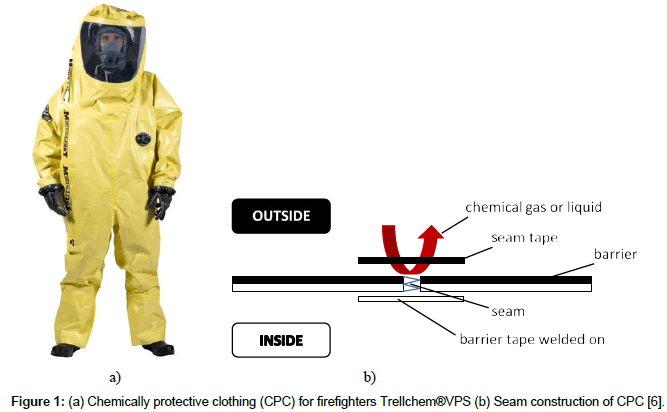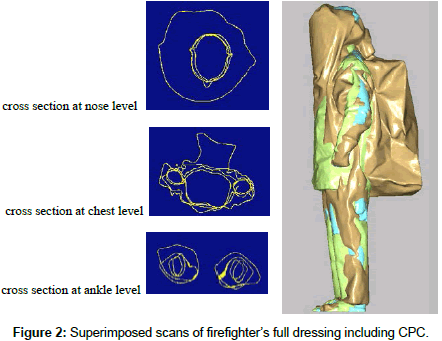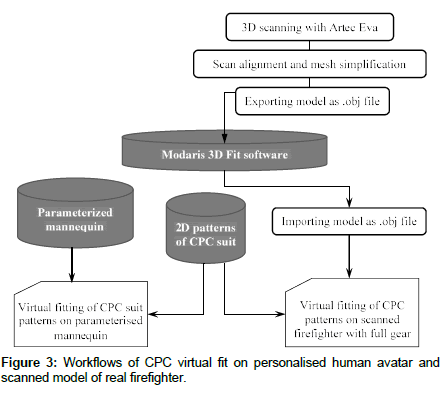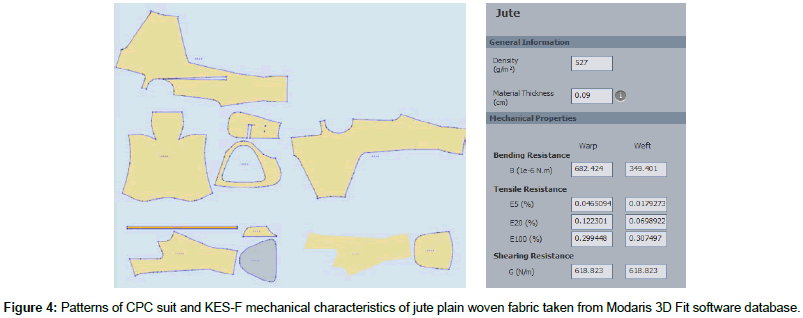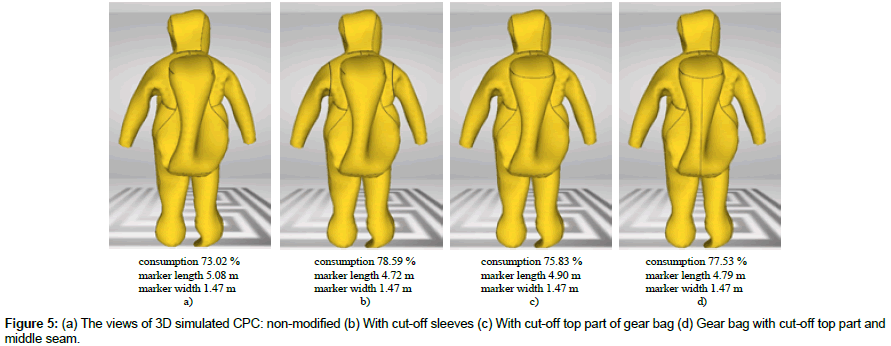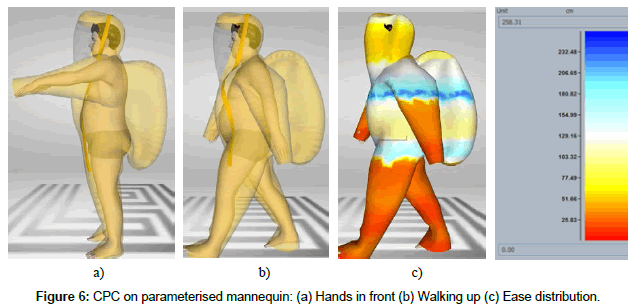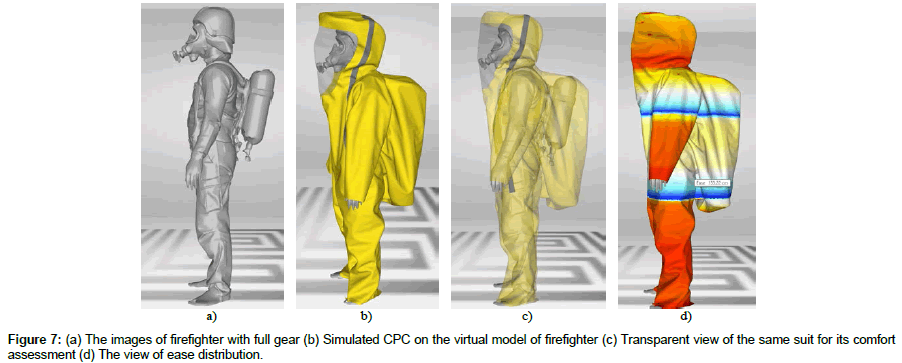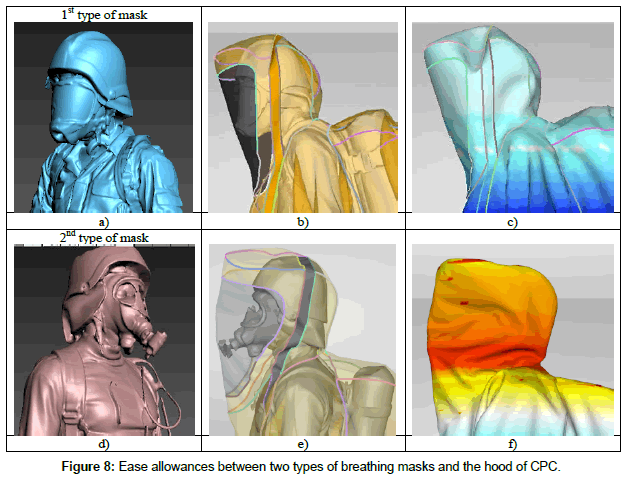Research Article, J Fashion Technol Textile Eng S Vol: 0 Issue: 4
Virtualization and Mass Customization of Safe Work Wear
Eugenija Strazdiene1*, Violeta Bytautaite1, Inga Dabolina2 and Daivute Krisciuniene3
1Vilnius University of Applied Sciences, Lithuania
2Riga Technical University, Latvia
3JSC Ansell Protective Solutions Lithuania, Lithuania
*Corresponding Author : Eugenija Strazdiene
Vilniaus kolegija/University of Applied Sciences, Didlaukio str. 82, LT-08303 Vilnius, Lithuania
Tel: + 370 5 219 1720
Fax: 370 5 219 1722
E-mail: e.strazdiene@mtf.viko.lt
Received: December 12, 2017 Accepted: February 21, 2018 Published: February 27, 2018
Citation: Strazdiene E, Bytautaite V, Dabolina I, Krisciuniene D (2018) Virtualization and Mass Customization of Safe Work Wear. J Fashion Technol Textile Eng S4:007. doi:10.4172/2329-9568.S4-007
Abstract
The object for the investigation is chemical protective clothing (CPC), which totally coves dressed human body together with gear: breathing apparatus, breathing mask and helmet. The end users of such clothing are the members of rescue team – firefighters. The results of 3D scanning with stationary Vitus Smart XXL scanner and portable Artec Eva scanner are compared on the basis of the efficiency of scanning procedure and scanning accuracy. Also, the possibilities to exporting scanned bodies into specialized CAD systems for suit design development and material consumption calculation are analysed. The necessity to understand and to implement corresponding clothing material properties during 3D visualization of garment on CAD systems are presented. Obtained results showed, that virtual fitting supplemented by scanning procedure significantly contribute for the implementation of mass customization concept not only for traditional garments, but for specialized work wear, as well.
Keywords: Safe work wear; 3D scanning; CAD system; Mass customization
Introduction
Nowadays it becomes clear that fashion, including specialised clothing, and its mass production, needs to find a way of restructuring itself and its supply chain to effectively serve the customer and business. This restructuration is inspired by industrial revolution, which is effecting all spheres of human life. Contemporary 4th industrial revolution provides solutions with a further increase in the efficiencies of the value chain through data analysis, robotics, sensors and 3D printing, which are closely related to computer generated simulation of a three-dimensional image overlaid to the physical world – augmented reality (AR) or a complete environment – virtual reality (VR). Intensive digitization of the majority of design and manufacturing processes leads to mass customization, which still is not widely available option for companies producing fashion and specialised clothing, e.g. personal protective garments. One variation of mass customization involves co-design in which a products design is based on the customer selection from a range of design features offerings [1]. Advances in digital technology allow reductions in the intensity of labour, cost and the need for customers to attend time-scarcity fittings while keeping the quality and service. Besides, digitization of processes has made great advances in design and manufacturing of mass production through the availability and more common use of methods such as digital printing, 3D pattern-cutting, 3D tailoring, co-creation; styling, fabric simulation, body-scanning and virtual try-on [2].
The widespread use of CAD/CAM systems in garment industry to design patterns along with database resulting from 3D scanning technology of the human body, are perquisites for virtual modelling of the dimensional correspondence between 2D patterns and concrete human body. Nowadays CAD systems has grown into an industry of its own by producing: 2D graphics software packages such as Illustrator and CorelDRAW; packages that have been customised for the fashion design such as Kaledo Style, Vision Fashion Studio, Tex-Design; specialised 2D pattern making CAD software, including packages such as Cad.Assyst, Modaris, AccuMark, Master Pattern Design, TUKAcad, GRAFIS, Audaces Apparel [3,4].
All these innovations concern not only traditional garment industry, but specialized protective clothing, as well. Protection against harmful chemical materials is compulsory in many aspects of everyday life. Different types of materials and garment designs are used in these clothing items, and protection levels vary considerably. Due to the huge number of variables involved, numerous levels and types of chemical protective clothing systems has been technologically developed [5]. It must be noted that such clothing is worn on fully dressed human body and often equipped with specialized gear, what makes comfort fitting of them more complicated. Thus, the aim of this research was to develop the digitized method of chemical protective clothing (CPC) prototype generation, which would comprise 3D scanning with hand-held scanner technology together with virtual fitting, 2D pattern creation and material consumption calculation software by providing maximal comfort of developed clothing.
The Object of the Investigation
The object of the investigation was chemical protective clothing (CPC) for firefighters Trellchem® VPS (size XL). Its material – a wellproven combination of rubber and a multilayer chemical barrier provides excellent chemical protection for more than 8 hours, as well as great abrasion and flame resistance. The suit follows the requirements of standards: EN 943-2/ET; EN 943-1; EN 1073-2; EN 14126 (Figure 1a) [6].
Figure 1: (a) Chemically protective clothing (CPC) for firefighters Trellchem®VPS (b) Seam construction of CPC [6].
Seams in CPC are weak links as any joints in a construction of traditional garments. Trellchem® has developed a seam, which is just as chemical resistant, and sometimes even better, than the garment material itself. The most important part of seam construction is the welded on barrier tape (Figure 1b), with which the barrier film becomes unbroken i.e. continuous all over the suit, and thereby guarantees the same or even longer permeation times than the suit material itself. The other important part of CPC is a visor, which is made from a rigid 2 mm impact and chemical resistant PVC. The standard zipper used in this CPC is a strong and durable gastight chloroprene coated with rubber. This CPC suit is resistant to a wide range of chemicals. Ansell Barrier® inner glove and an outer rubber glove, either Trellchem® Viton®/Butyl rubber glove are attached with the Trellchem® Bayonet glove ring system, which offers quick and simple glove exchange. Suits can be fitted with either sewn-in socks/ booties made of the garment material or attached Nitrile rubber safety boots with European approval as Firemen’s boots. Due to its construction, this CPC is used in such situations: accidental release of toxic gases; biohazard response; maintenance of plant and machines, plant emergencies, unexpected leakages spills or other releases [6].
The Workflows of CPC Virtual Fittings
In this research preliminary scanning of firefighter dressed with chemical protective clothing (CPC) and firefighter’s costume were performed with Vitus Smart XXL scanner at Riga Technical University. Scanning results are presented in Figure 2, which shows the possibility to superimpose several scanned images one upon the other in order to evaluate ease gaps between the different layers of firefighter’s full dressing. It justifies the possibility to assess the comfort level of CPC.
The next step must be the adjustment of CPC patterns in respect to the most optimal ease allowances between the dressed firefighter’s body with full gear (breathing apparatus, helmet and breathing mask) and the surface of CPC, which nowadays is performed with contemporary pattern making and virtual fitting CAD systems. For this reason firefighters were scanned with hand-held scanner Artec Eva, not stationary full body scanner, as this had to be done in their work place not distracting firefighters from their job. Modaris 3D Fit (Lectra) CAD system was chosen for CPC virtual fitting and its comfort assessment, because this software provides control early on in the product lifecycle, i.e. shortens garment development cycle by reducing the need for time consuming physical samples, manual grading and physical fit sessions. After the generation of firefighter’s virtual body, it can be imported into this software for CPC visualization and simulation on scanned model [4].
Figure 3 presents full sequence of firefighter’s scanning and CPC virtual fitting in two workflows: the 1st flow - for personalized human avatar and the 2nd flow – for the model of fully dressed real firefighter equipped with gear. This is important, because CPC must cover not only the body of firefighter, but also his breathing apparatus, helmet and breathing mask, which may be of different types and modifications.
CPC Virtualization on Parameterized Mannequin - 1st Flow
During the 1st workflow the mannequin (height 182.1 cm, bust 124.8 cm, hips 125.7 cm) from Modaris 3D Fit (Lectra) software database was used for the investigation of CPC virtualization possibilities. The patterns of CPC are presented in Figure 4 together with the KES-F mechanical characteristics of material taken from the same database - plain woven jute surface density of which is 527 g/m2. Similar to barrier material used in CPC, jute has high bending and shearing resistances in warp and weft direction.
The simulation process of CPC on parameterised mannequin is more complicated compared to ordinary clothing, such as dress, coat, skirt or shirt, because in Modaris 3D Fit software three types of slip-on points neck, hands and legs are used for garment draping simulation. It means that draping of hood, front visor and the bag for breathing gear on the back must be draped manually using pull fabric by point or line function. However, such type of clothing as CPC can be simulated and visualized in Modaris 3D Fit software, what is important for mass customization concept realization. Even more, the adjustments of patterns can be done in real time together with the verification of garments 3D view. The example of this can be the modifications of suit patterns with the aim to reduce material consumption.
In Figure 5 the views of CPC are presented as follows: a) nonmodified; b) with cut-off sleeves; c) with cut-off top part of gear bag; d) with gear bag with cut-off top part and middle seam. It is evident that splitting of suits big patterns into smaller ones perfects material consumption. Markers were made with Diamino (Lectra) software. Nevertheless, final decision must be made taking into account and balancing technological cost of such modifications.
The other important function in clothing personalization (customization) is its comfort at different body positions, particularly for working clothing. Modaris 3D Fit software allows testing the behaviour of clothing and its material in several body positions. Figure 6 presents CPC draped on parameterised mannequin: a) hands stretched in front; b) walking up. It can be seen (Figure 6c) that the highest ease values are at the cross sections of back bag zone (up to 230 cm) due to missing breathing apparatus and at the cross sections of hood zone (up to 100 cm) due to missing breathing mask and helmet. Maximal strains in garment can be defined by analysing 3D mesh deformations. For this concrete case suit deformation is nearly even - varies between 5% and 25%. Only in the zones where back bag and helmet are joined to the main garment deformation is between 35% and 50%.
CPC Virtualization on Scanned Firefighter with Full Gear - 2nd Flow
During the 2nd workflow the model (.obj file type) of fully dressed real firefighter equipped with gear was imported into Modaris 3D fit software. Figure 7 shows the results of CPC simulation on the body of firefighter the measurement of which were: height 184 cm, bust 110 cm, hips 113 cm.
The images are presented in four variations: 1) firefighter with full gear, 2) simulated CPC on the virtual model of firefighter, 3) transparent view of the same suit for its comfort assessment, 4) the view of ease distribution on simulated suit. It must be noted that in this case, the same as for parameterised mannequin, the highest ease values are at two cross sections of back bag zone - up to 150 cm on its top and bottom. Transparent side view of simulated CPC suit shows that back bag is too big for breathing apparatus. The decision was made to shorten it by 25 cm. It provides some lightness for the suit, even more that its material is very heavy - surface density of jute is 527 g/m2. Material consumption for shortened back bag is 76.10 % (marker length 4,90 m; marker width 1.47 m); for shortened back bag with middle seam – 79.26 % (marker length 4,70 m; marker width 1.47 m).
The gear, which is worn for different jobs differs in size and shape. Scanning of workers with different types of equipment allows customizing clothing taking into account not only workers body shape and measurements, but the size of worn equipment, as well. Figure 8 shows two types of breathing masks worn under CPC. The 1st type of mask is shorter and smaller, thus there is small ease allowance between the mask and the hood of the suit. Meantime the mask of the 2nd type is longer and the hood at this zone experiences some tension. The pattern of the hood for this type of breathing mask has to be modified according to these results. Obtained results show, that virtual fitting supplemented by scanning procedure significantly contributes for the implementation of mass customization concept not only for traditional garments, but for complicated work wear, as well. Especially it is important that virtual fitting on scanned models allows simulating garments on bodies wearing different gears, e.g. firefighter’s with breathing equipment. It saves pattern making and adjustment time and allows to evaluate material consumption straight of.
Conclusions
Virtual fittings of CPC on parameterized mannequin from Lectra database and on scanned firefighter with full gear justifies the possibility to assess the comfort level of specialized clothing, but it depends on the construction of the garment. In Modaris 3D fit software three types of slip-on points neck, hands and legs are used for garment draping simulation. It means that draping of hood, front visor and the bag for breathing gear on the back must be draped manually using pull fabric by point or line functions, because no slip-on point is provided for such parts of clothing. It is also important that scanning of workers with different types of equipment allows customizing clothing taking into account not only workers body shape and measurements, but the size of worn equipment. Even more that the gear, which is worn for different jobs differs in size and shape.
Acknowledgment
This research work was partially financed by the European Union’s European Regional Development Fund, through the INTERREG BSR Programme, which awarded a grant to the SWW project (#R006). The authors gratefully acknowledge the received financial support. Also the authors are thankful for Riga Technical University for the possibility to use Vitus Smart XXL (Human Solutions GmbH, Germany) scanner.
References
- Kim E, Fiore AM, Kim H (2011) Fashion trends: analysis and forecasting. Bloomsbury, New York, USA.
- Vecchi A, Buckley C (2016) Handbook of research on global fashion management and merchandising. IGI Global, Pennsylvania, USA.
- Spahiu T, Shehi E, Piperi E (2014) Advanced CAD/CAM systems for garment design and simulation.
- Rahman M, Rayyaan R, Nur G, Saaqib N, Shibly MH (2015) An exploratory study on modern 3d computerised body scanning system and various types of pattern making software’s with their constructive implementation in apparel industry. Eur Sci J 11: 1-15.
- Khalil E (2015) A technical overview on protective clothing against chemical hazards. AASCIT Journal of Chemistry 2: 67-76.
- Ansell (2017) Chemical products.
 Spanish
Spanish  Chinese
Chinese  Russian
Russian  German
German  French
French  Japanese
Japanese  Portuguese
Portuguese  Hindi
Hindi 